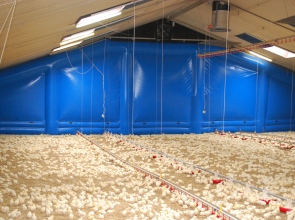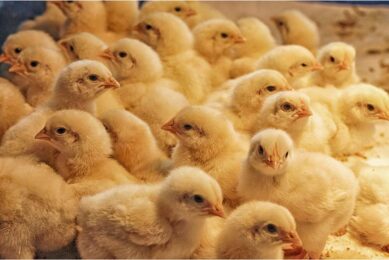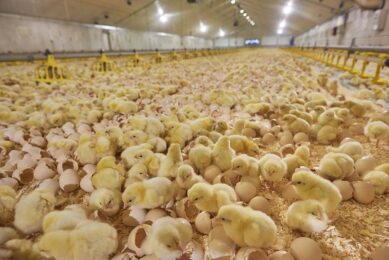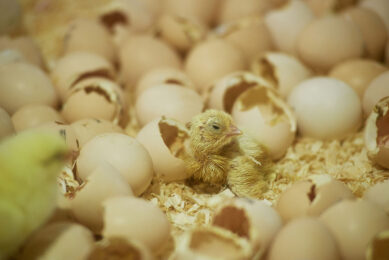Smart air wall saves on energy costs

An inflatable air wall easily splits a broiler house in two sections. Thus a brooding area exists, which can be heated at a much lower cost. Building it up and taking it out is not much work at all.
By Ad Bal
Heating broiler houses is a major cost factor, particularly in cold and moderate regions. Since the floor is usually still wet when the day old chicks arrive and warm air is moving in an upward direction, much energy is needed to create a comfortable climate at chick level. The inflatable “smart air wall” of Sidijk from the Netherlands is a solution to create a smaller brooding section and thus a smaller volume inside the house. As a result, less energy is needed to warm it up. After all, the day old chicks don’t need all the space in the beginning.
Inflatable frame
The Smart air wall is a 70 cm thick inflatable partition. It fits exactly into the interior cross section of the building. The tubes of the frame are inflatable, whereas in the space of the double wall in between, there’s no air pressure. Openings at floor level allow room for the feeder and drinker lines. Underneath the roof, there is a fan that proportionally moves warm air and thus pre-warms the part of the house next to this brooding section.
The Smart air wall is a 70 cm thick inflatable partition. It fits exactly into the interior cross section of the building. The tubes of the frame are inflatable, whereas in the space of the double wall in between, there’s no air pressure. Openings at floor level allow room for the feeder and drinker lines. Underneath the roof, there is a fan that proportionally moves warm air and thus pre-warms the part of the house next to this brooding section.
Less than one hour
The idea of the smart air wall came from broiler farmer Tseard Snoek from the Netherlands. He hired Sidijk to make this according to his specifications. He has used it for growing one flock already and the results are promising. The system seems to work very well. Setting up the air wall takes only half an hour and taking it down only just a few minutes longer.
The idea of the smart air wall came from broiler farmer Tseard Snoek from the Netherlands. He hired Sidijk to make this according to his specifications. He has used it for growing one flock already and the results are promising. The system seems to work very well. Setting up the air wall takes only half an hour and taking it down only just a few minutes longer.
At the start of the growing period, the temperature difference between the brooding area and the rest of the house was about 14 degrees Celsius during the first round. The birds were kept in the brooding section for two weeks after which they were given access to the full space in the house. At the moment the smart air wall was taken away, temperature difference between the two areas was only two degrees. Snoek expects the investment in the system to be paid back within only two years.
| Small openings in the curtain allows the feeder lines to pass through, but prevent the chicks from moving to the other part of the house. | The chicks will stay from day-old until two weeks of age in the brooding area, after which the entire air wall can be taken out. |
MORE INFORMATION













